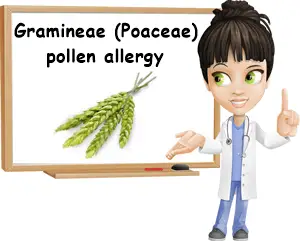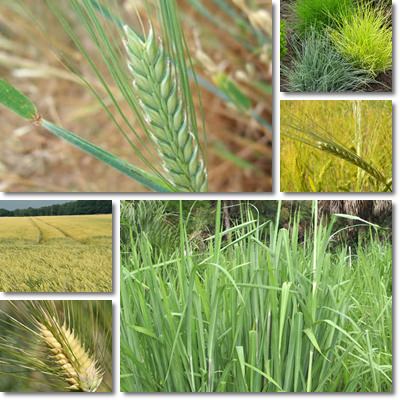Grasses are plants in the Gramineae or Poaceae family and a source of allergic reactions. Most often, people allergic to grasses exhibit allergic reactions to more than one species of the family. Because grasses can be found virtually on every continent, grass pollen allergy is one of the most widespread pollen allergies. From late spring to early autumn, grasses produce a highly allergenic pollen which is carried in the air over great distances, reaching great numbers of people and causing various allergy levels.
What is grass allergy? Grass allergy is simply allergy to grass pollen and it is common in both children and adults. What causes Gramineae allergy to be so common is the fact that grasses produce a highly allergenic pollen which is irritating for the airways and lungs when breathed in and for the skin in cases of direct exposure. What happens is the immune system recognizes the presence of pollen from grasses and perceives it as a threat to the body, much like bacteria, viruses or parasites. This overreaction leads to the immune system activating itself to remove the pollen.

How does grass allergy work? Grass allergy occurs when a person has an overactive immune system which sees harmless elements such as dog hair, dust, flower pollen or grasses pollen as pathogenic agents. This engenders a chain of immune system reactions meant to eliminate the allergen. B cells of the immune system produce immunoglobulins (or antibodies) called IgE that bind to the allergen. This causes mast cells and basophils (both white blood cells) to degranulate, releasing histamine. In its turn, histamine causes extensive inflammation that results in symptoms of an allergic reaction and even anaphylactic shock. Basically, what causes allergy to grass pollen is an innate or acquired sensitivity to pollen from grass species.
Diagnosing grass allergy or other allergies is done with the help of:
1) Skin allergy test. The skin is pricked, scratched or scraped lightly and allergens are applied to see if they elicit any skin reaction.
2) RAST test. It is a blood test that looks for antibodies to certain allergens.
3) Patch test. Potential or known allergens are stuck to the skin for 24-48 hours to see if they generate any inflammatory allergic reaction.
Causes of grass allergy
What causes allergy to grass pollen are grass species with high allergenic potential such as:
1) Wheat, oats, barley, maize, rye, sorghum, melic grass, durum wheat.
2) Common couch, couch grass or dog grass (Elymus repens).
3) Bentgrass (Agrostis).
4) Buffalo grass or vanilla grass (Anthoxanthum odoratum).
5) Timothy-grass (Phleum pratense).
6) Orchard grass (Dactylis glomerata).
7) Perennial rye grass (Lolium perenne).
8) Bermuda grass or dog’s tooth grass (Cynodon dactylon).
9) Tall fescue (Festuca arundinacea).
10) Annual meadow grass (Poa annua), common meadow grass (Poa pratensis).
11) Johnson grass (Sorghum halepense).

Signs and symptoms
What are the symptoms of grass allergy? The symptoms of grass allergy are the same as those of any allergy. However, different people exhibit different levels of immune system sensitivity to various allergens and, as a result, may affect one or more organs and be mild or severe. Here are the most common signs and symptoms of grass allergy:
1) Trouble sleeping is a common allergy symptom and can appear as insomnia, agitation, disturbed sleep.
2) Sneezing, stuffy nose, runny nose with clear or white mucus (learn more about mucus color).
Nasal congestion occurs within minutes of exposure to grass pollen and can be intense.
3) Allergic conjunctivitis: red, itchy, watery eyes.
4) Allergic sinusitis: sinus aching or pressure with nasal congestion and white or clear mucus.
Gray streaks of color in the mucus often indicate the presence of airborne dust particles.
5) Chest tightness (it’s important to learn to distinguish allergy symptoms from cardiac arrest).
6) Difficulty breathing, wheezing, coughing.
7) Itchy throat, indicating the allergens have been inhaled. Itching is most intense around the tonsils and back of throat.
8) Allergic asthma attacks and laryngospams caused by the allergens being present in the lungs and throat.
9) Itchiness inside ears or, less common for allergies, itchiness of the external ear. Fullness in ear is also common in allergies.
10) Skin rash, in cases of direct contact with grass pollen.
11) Diarrhea, nausea present in people extremely sensitive to the allergens.
The greatest complication of allergies is anaphylactic shock. A severe allergy to grass or other pollen species or excessive exposure can build up towards anaphylaxis. Symptoms of anaphylactic shock include throat itching, swelling of the tongue, skin rash, closing of airways and obstructed breathing and low blood pressure that causes lightheadedness, cardiovascular collapse and coma. Because anaphylaxis is life-threatening, family, friends, colleagues, teachers and others close to you should be let known if you suffer from allergies and what types. Making your condition known will allow others to offer you the help you need in case of a medical emergency.
Recommendations
The best way to deal with grass allergies, parietaria allergies and other pollen allergies is prevention. This may include any of the following measures and treatments:
1) Avoidance. If possible, avoid exposure to the allergen altogether.
2) Avoid going out on dry, windy days and immediately after the rain when pollen is broken down and rises into the air.
3) Make sure your work place and home have sufficient air humidity with the help of a humidifier or vaporizer.
Humidity can inactivate allergens and reduce the risk of allergic reactions, laryngospasms and asthma attacks.
4) Clean air by cleaning or changing air conditioner filters regularly.
5) Change clothes, wash face and hair as soon as possible after exposure to allergens.
6) Cleanliness. Allergens travel everywhere so make sure to use different clothes for going out and staying indoors, change bedding regularly, dry clothes indoors in the dryer, clean sofas and carpets often or, even better, avoid carpets altogether because they fill up on dust, pollen and other allergens.
7) In case of laryngospasms, carry water with you at all times and drink in small sips to inactivate allergens. I find naturally sparkling water is better than still water.
8) Carry your medication with you at all times and inform those you are close with about your condition.
9) Avoid problematic foods such as sugary carbonated drinks, coffee, alcohol, foods that cause acidity, foods that cause gastritis etc. They increase the risk of allergic reactions, especially those affecting the respiratory system.
Conclusion
There are different levels of grass allergy with more mild or severe symptoms. Because grass allergy can potentially cause anaphylactic shock, probably the most important curative measures to consider are to avoid exposure to the allergen and carry your medication with you at all times. In my experience, taking 1 g of vitamin C daily weeks before the grass allergy season begins and throughout it helps better manage my allergies because of the natural antihistamine properties of ascorbic acid.
